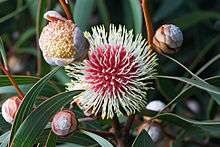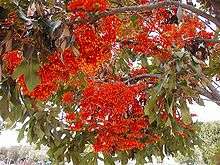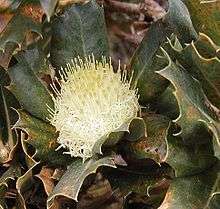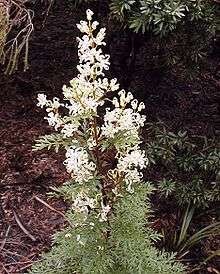Grevilleoideae
The Grevilleoideae are a subfamily of the flowering plant family Proteaceae. Mainly restricted to the Southern Hemisphere, it contains around 46 genera and about 950 species. Genera include Banksia, Grevillea, and Macadamia.
| Grevilleoideae | |
|---|---|
 | |
| Inflorescence and leaves of the pin-cushion hakea (Hakea laurina) | |
| Scientific classification | |
| Kingdom: | Plantae |
| Clade: | Tracheophytes |
| Clade: | Angiosperms |
| Clade: | Eudicots |
| Order: | Proteales |
| Family: | Proteaceae |
| Subfamily: | Grevilleoideae Engl. |
| Genera | |
|
See text | |
Description
The Grevilleoideae grow as trees, shrubs, or subshrubs. They are highly variable, making a simple, diagnostic identification key for the subfamily essentially impossible to provide. One common and fairly diagnostic characteristic is the occurrence of flowers in pairs that share a common bract. However, a few Grevilleoideae taxa do not have this property, having solitary flowers or inflorescences of unpaired flowers. In most taxa, the flowers occur in densely packed heads or spikes, and the fruit is a follicle.
Distribution and habitat
Grevilleoideae are mainly a Southern Hemisphere family. The main centre of diversity is Australia, with around 700 of 950 species occurring there, and South America also contains taxa. However, the Grevilleoideae are barely present in Africa; almost all of the Proteaceae taxa there belong to the subfamily Proteoideae.[1] The Brabejum tree of Cape Town is the exception, and the only grevilleoid in Africa.
Taxonomy



The framework for classification of the Proteaceae was laid by L.A.S. Johnson and Barbara Briggs in their 1975 monograph "On the Proteaceae: the evolution and classification of a southern family".[2] Their classification has been refined somewhat over the ensuing three decades, most notably by Peter H. Weston and Nigel Barker in 2006. The Grevilleoideae are now considered one of five subfamilies of the Proteaceae. The placement and circumscription of the Grevilleoideae according to Weston and Barker can be summarised as:[3]
Family Proteaceae Juss.
- Subfamily Bellendenoideae P.H.Weston(1 genus)
- Subfamily Persoonioideae L.A.S.Johnson & B.G.Briggs(2 tribes, 5 genera)
- Subfamily Symphionematoideae P.H.Weston & N.P.Barker(2 genera)
- Subfamily Proteoideae Eaton (4 tribes, 5 subtribes, 25 genera)
- Subfamily Grevilleoideae Engl.
- incertae sedis
- Tribe Roupaleae Meisn.
- incertae sedis
- Megahertzia — Knightia — Eucarpha — Triunia
- Subtribe Roupalinae L.A.S.Johnson & B.G.Briggs
- Subtribe Lambertiinae (Venk.Rao) L.A.S.Johnson & B.G.Briggs
- Subtribe Heliciinae L.A.S.Johnson & B.G.Briggs
- Subtribe Floydiinae L.A.S.Johnson & B.G.Briggs
- incertae sedis
- Tribe Banksieae Rchb.
- fossil form genera
- Subtribe Musgraveinae L.A.S.Johnson & B.G.Briggs
- Subtribe Banksiinae L.A.S.Johnson & B.G.Briggs
- Tribe Embothrieae Rchb.
- Subtribe Lomatiinae L.A.S.Johnson & B.G.Briggs
- Subtribe Embothriinae Endl.
- Embothrium — Oreocallis — Alloxylon — Telopea
- Subtribe Stenocarpinae L.A.S.Johnson & B.G.Briggs
- Subtribe Hakeinae Endl.
- Opisthiolepis — Buckinghamia — Hakea — Grevillea — Finschia
- Tribe Macadamieae Venk.Rao
- Subtribe Macadamiinae L.A.S.Johnson & B.G.Briggs
- Subtribe Malagasiinae P.H.Weston & N.P.Barker
- Subtribe Virotiinae P.H.Weston & N.P.Barker
- Subtribe Gevuininae L.A.S.Johnson & B.G.Briggs
- Cardwellia — Sleumerodendron — Euplassa — Gevuina — Bleasdalea — Hicksbeachia — Kermadecia — Turrillia
The tribes of Grevilleoideae given by Weston and Barker [3] are shown below:
| |||||||||||||||||||||||||
Uses
The nursery industry cultivates many Grevilleoideae species as barrier plants and for their prominent and distinctive flowers and foliage. Some species are of importance to the cut-flower industry, especially some Banksia and Dryandra species. Two species of the genus Macadamia and the Chilean species Gevuina avellana (Chilean hazel) are grown commercially for edible nuts. Chilean hazel has an acceptable frost tolerance.
References
- Orchard, Anthony E. (ed.). "Proteaceae". Flora of Australia, Volume 16: Elaeagnaceae, Proteaceae 1. Melbourne: Australian Biological Resources Study / CSIRO Publishing. Archived from the original on 2006-10-31. Retrieved 2006-06-28.CS1 maint: extra text: authors list (link)
- L. A. S. Johnson and Briggs, B. G. (1975). "On the Proteaceae: the evolution and classification of a southern family". Journal of the Linnean Society of London. Botany. 70 (2): 83–182. doi:10.1111/j.1095-8339.1975.tb01644.x.
- Weston, Peter H.; Barker, Nigel P. (2006). "A new suprageneric classification of the Proteaceae, with an annotated checklist of genera" (PDF). Telopea. 11 (3): 314–344. Archived from the original (PDF) on 2009-10-02.
External links
| Wikispecies has information related to Grevilleoideae |

